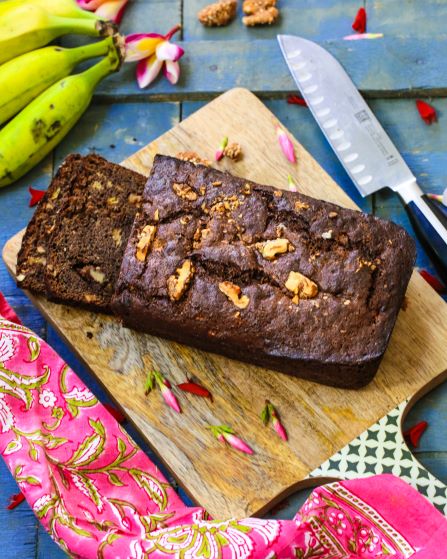
Personally I don’t have an issue with gluten at all, but when my son suffered extreme digestive distress, he was asked to go off gluten completely for three months. In that time, I accumulated a whole pantry full of gluten-free products to experiment with (and we also ate a ton of rice!) But the outcome was that I was able to develop a whole group of new recipes and learn about innovative ingredients while he was under treatment.
One of the healthy gluten-free options I explored was banana flour. More correctly it was green or raw banana flour. Green banana flour is simply the raw banana dried and ground with no additives. It has historically been used in Africa and Jamaica, and is now a gluten-free flour growing in popularity! But it’s not a new flour – it was sold in Central America as early as the 1900s.
I expected the raw flour to have the aroma or taste of bananas. While this greyish flour (See picture below) does smell like bananas, there is no obvious banana taste. Once it is cooked, it develops an earthy flavour and also darkens – most likely due to the enzymes in the banana flour and the Maillard reaction (a chemical reaction between an amino acid and a reducing sugar, usually requiring the addition of heat. Like caramelization, it is a form of non-enzymatic browning. (Read this article from The Science of Cooking to learn more.) As you can see, baking with pure banana flour results in a chocolate-brown bread. The enzymatic brown effect can be reduced somewhat by adding in other gluten-free flours, or adding more acid to the bread.

Banana flour also absorbs more water than wheat flour, due to its high starch content, which results in a higher water absorption capacity. So if you are using it as a replacement in a recipe for grain flours, recommendations are to use 25-30% less, keeping other ingredients constant.
Banana flour, like the bananas it is made from, is loaded with minerals – predominantly potassium, magnesium and manganese. More importantly, green banana are abundant in resistant starch. Resistant starch “resists” the process of breaking down into sugars. This may help lower blood sugar levels, and also may help you feel more satiated. It lowers pH levels and helps reduce cell damage. An additional benefit of resistant starch is that it helps form good bacteria in the gut, and keeps colon cells healthy (read more here.)
But at the end of the day, we are foodies and interested in yummy, tasty banana bread that is gluten-free! Try the easy recipe below for my Banana Banana Bread and you’ll get hooked on banana flour!
Banana Banana Bread
Ingredients:
- 3 very ripe bananas, peeled
- 1/3 cup melted butter
- 1 teaspoon baking soda
- ¼ teaspoon salt
- 2 eggs, beaten
- ¾ cup sugar (½ cup if you prefer a less sweet bread)
- 1 teaspoon vanilla extract
- 1 teaspoon vinegar
- 1 ¼ cup banana flour Buy Banana Flour now from Amazon.in !
- 1/3 cup walnut (optional). Buy walnuts now from Amazon.in !
Instructions:
- Preheat the oven to 350 F (175 C). Butter a 4×8- inch loaf pan.
- In a mixing bowl, mash the ripe banana with a fork or masher until bananas no longer have lumps.
- Stir the melted butter into the mashed bananas.
- Whisk the eggs.
- Stir in beaten eggs, the sugar, vanilla extract, vinegar, and walnuts.
- Combine baking soda and salt to the flour. Now add flour mixture to the banana mixture. Whisk only until well combined.
- Pour the batter into your prepared loaf pan. Bake for 50 minutes to 1 hour at 350F (175C)
- Remove from oven and let the banana bread cool in the pan for a few minutes.
- Remove from pan. Slice and serve.
Serves: One loaf
Ingredients: 10
Prep Time: 10 minutes
Cooking Time: 50 -60 minutes
Critical Ingredients: You could substitute brown sugar for the sugar – brown sugar has more moisture and acids, so your bread may be moister and rise a bit more. You could also combine the banana flour with coconut flour. There isn’t much of a taste difference even and texture difference using up to 30% coconut flour. Click here to buy coconut flour! Nuts are optional of course.




